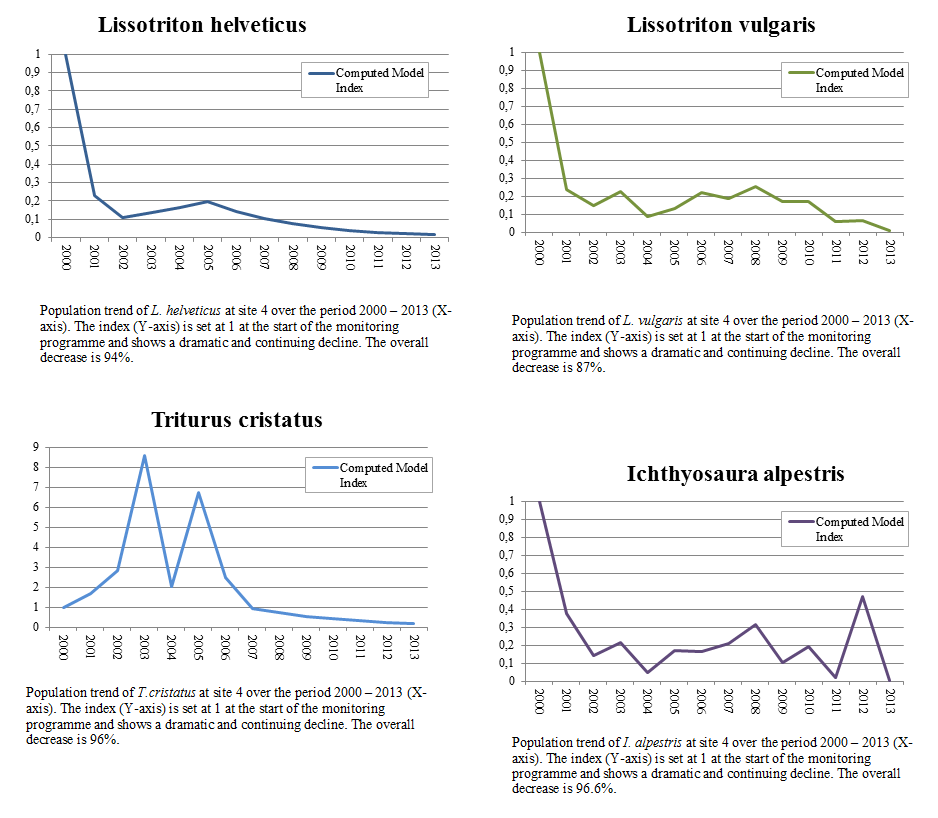Spitzen-van der Sluijs A, Martel A, Asselberghs J, Bales EK, Beukema W, Bletz MC, et al. Expanding distribution of lethal amphibian fungus Batrachochytrium salamandrivorans in Europe. Emerg Infect Dis. 2016 Jul [date cited]. http://dx.doi.org/10.3201/eid2207.160109
Expanding distribution of lethal amphibian fungus Batrachochytrium salamandrivorans in Europe
Annemarieke Spitzen-van der Sluijs, An Martel, Johan Asselberghs, Emma K. Bales, Wouter Beukema, Molly C. Bletz, Lutz Dalbeck, Edo Goverse, Alexander Kerres, Thierry Kinet, Kai Kirst, Arnaud Laudelaut, Luis F. Marin da Fonte, Andreas Nöllert, Dagmar Ohlhoff, Joana Sabino-Pinto, Benedikt R. Schmidt, Jeroen Speybroeck, Frank Spikmans, Sebastian Steinfartz, Michael Veith, Miguel Vences, Norman Wagner, Frank Pasmans and Stefan Lötters
Information on monitoring efforts in the years 2000–2013 at site 4
Four species of newts (great crested newts (Triturus cristatus), smooth newts (Lissotriton vulgaris), palmate newts (L. helveticus) and Alpine newts (Ichthyosaura alpestris)) occur in natural populations at site 4 (Wormdal, The Netherlands). All newt populations have shown severe population declines over the period 2000–2013. A direct causal relationship between the presence of the chytrid fungus Batrachochytrium salamandrivorans and the decrease of the newt populations at this site has not yet been demonstrated.
All newts at this site are monitored yearly according to the Dutch national standard (1). Population trend calculation was conducted following Spitzen-van der Sluijs A et al. (2), alpine newts and smooth newts have retrospective decreases of -96.6% and -87% in the period 2000–2013. The great crested newt population decreased by 96% as well, and the palmate newt population decreased by 94% (Figure 1).
Acknowledgements
M. de Zeeuw (CBS, the Netherlands)
References
- Groenveld A, Smit G, Goverse E. Handleiding voor het Monitoren van Amfibieën in Nederland. RAVON Werkgroep Monitoring, Amsterdam. 2011. http://www.ravon.nl/Portals/0/Pdf/Handleiding_MA_2011.pdf
- Spitzen-van der Sluijs A, Spikmans F, Bosman W, De Zeeuw M, Van der Meij T, Goverse E, et al. Rapid enigmatic decline drives the fire salamander (Salamandra salamandra) to the edge of extinction in the Netherlands. Amphib-Reptil. 2013;34: 233–239. http://dx.doi.org/10.1163/15685381-00002891
| Lissotriton helveticus |
|
Triturus cristatus |
|
Lissotriton vulgaris |
|
Ichthyosaura alpestris |
| Year |
Computed Model Index |
|
Year |
Computed Model Index |
|
Year |
Computed Model Index |
|
Year |
Computed Model Index |
| 2000 |
1 |
|
2000 |
1 |
|
2000 |
1 |
|
2000 |
1 |
| 2001 |
0.2283 |
|
2001 |
1.6792 |
|
2001 |
0.2357 |
|
2001 |
0.3764 |
| 2002 |
0.1104 |
|
2002 |
2.8197 |
|
2002 |
0.1462 |
|
2002 |
0.1407 |
| 2003 |
0.1348 |
|
2003 |
8.5967 |
|
2003 |
0.227 |
|
2003 |
0.2143 |
| 2004 |
0.1646 |
|
2004 |
2.0418 |
|
2004 |
0.0843 |
|
2004 |
0.0473 |
| 2005 |
0.1951 |
|
2005 |
6.7271 |
|
2005 |
0.134 |
|
2005 |
0.1707 |
| 2006 |
0.1422 |
|
2006 |
2.4949 |
|
2006 |
0.2198 |
|
2006 |
0.164 |
| 2007 |
0.1036 |
|
2007 |
0.9253 |
|
2007 |
0.1889 |
|
2007 |
0.2093 |
| 2008 |
0.0755 |
|
2008 |
0.7088 |
|
2008 |
0.2529 |
|
2008 |
0.3165 |
| 2009 |
0.055 |
|
2009 |
0.5429 |
|
2009 |
0.1727 |
|
2009 |
0.102 |
| 2010 |
0.0401 |
|
2010 |
0.4159 |
|
2010 |
0.1717 |
|
2010 |
0.1909 |
| 2011 |
0.0292 |
|
2011 |
0.3185 |
|
2011 |
0.0613 |
|
2011 |
0.0181 |
| 2012 |
0.0213 |
|
2012 |
0.244 |
|
2012 |
0.0641 |
|
2012 |
0.474 |
| 2013 |
0.0155 |
|
2013 |
0.1869 |
|
2013 |
0.011 |
|
2013 |
0.0012 |
